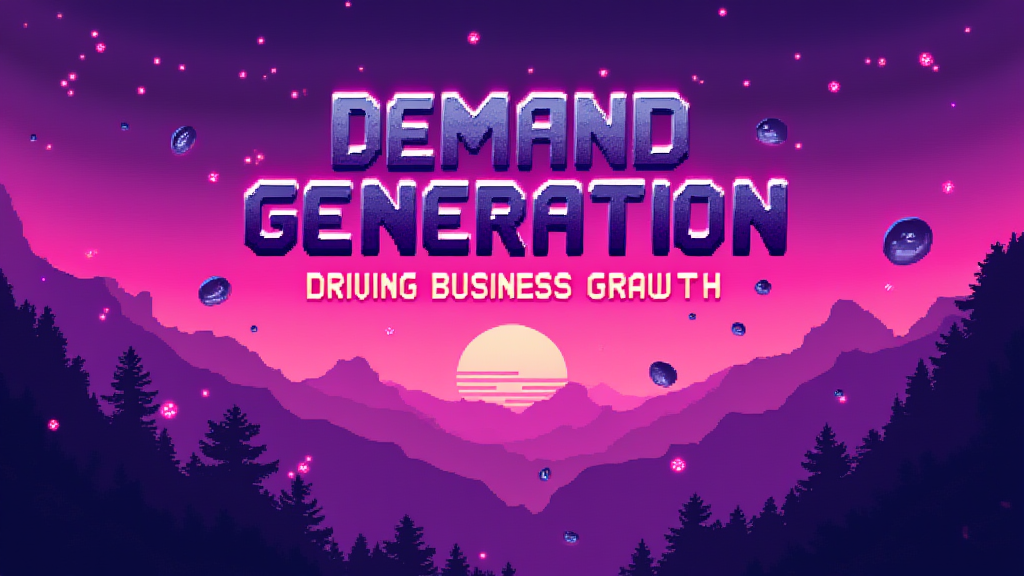Demand Generation: Driving Business Growth

Published on: October 01, 2024
Demand generation is a crucial marketing strategy that focuses on creating awareness and interest in a company's products or services among potential customers. This comprehensive approach aims to stimulate market demand, drive high-quality leads, and ultimately fuel business growth. 🚀
Understanding Demand Generation
At its core, demand generation is about:
- Building brand awareness
- Educating prospects about your offerings
- Nurturing potential customers through the buyer's journey
- Generating qualified leads for sales teams
Unlike traditional lead generation strategy, which often focuses on short-term tactics, demand generation takes a more holistic, long-term approach to creating and nurturing customer interest.
Key Components of Demand Generation
A successful demand generation strategy typically includes:
- Content Marketing: Creating valuable, relevant content to attract and engage target audiences
- Inbound Marketing: Attracting prospects through helpful resources and experiences
- Account-Based Marketing (ABM): Targeting specific high-value accounts with personalized campaigns
- Marketing Automation: Using technology to streamline and optimize marketing efforts
- Multi-Channel Engagement: Leveraging various channels to reach and interact with potential customers
Demand Generation vs. Lead Generation
While often used interchangeably, demand generation and lead generation have distinct differences:
| Aspect | Demand Generation | Lead Generation |
|---|---|---|
| Focus | Creating interest and awareness | Capturing contact information |
| Timeframe | Long-term strategy | Short-term tactics |
| Goal | Build brand reputation and market presence | Generate immediate leads for sales |
| Metrics | Brand awareness, engagement, pipeline value | Number of leads, conversion rates |
Measuring Demand Generation Success
To gauge the effectiveness of demand generation efforts, marketers often track key performance indicators (KPIs) such as:
- Website traffic and engagement
- Content downloads and shares
- Marketing qualified leads (MQLs)
- Sales qualified leads (SQLs)
- Pipeline velocity
- Customer acquisition cost (CAC)
- Return on investment (ROI)
Challenges in Demand Generation
While demand generation can be highly effective, it comes with its own set of challenges:
- Aligning marketing and sales teams
- Creating compelling, relevant content consistently
- Adapting to changing buyer behaviors and preferences
- Measuring and attributing results accurately
- Balancing short-term goals with long-term strategy
Best Practices for Effective Demand Generation
To maximize the impact of your demand generation efforts:
- Develop a deep understanding of your target audience
- Create high-quality, valuable content tailored to each stage of the buyer's journey
- Implement a robust marketing automation system
- Align marketing and sales teams around shared goals and metrics
- Continuously test, measure, and optimize your strategies
By embracing these best practices, businesses can create a powerful demand generation engine that drives sustainable growth and builds lasting customer relationships. 💼🤝
Implementing Demand Generation in Your Organization
As you consider implementing or improving your demand generation strategy, ask yourself these questions:
- How well do we understand our target audience's needs and pain points?
- Are our marketing and sales teams aligned on goals and processes?
- What content do we currently have, and what gaps need to be filled?
- How can we leverage technology to streamline our demand generation efforts?
- What metrics should we track to measure the success of our demand generation initiatives?
By addressing these questions, you'll be well on your way to developing a robust demand generation strategy that drives business growth and establishes your company as a leader in your industry. 🏆
















